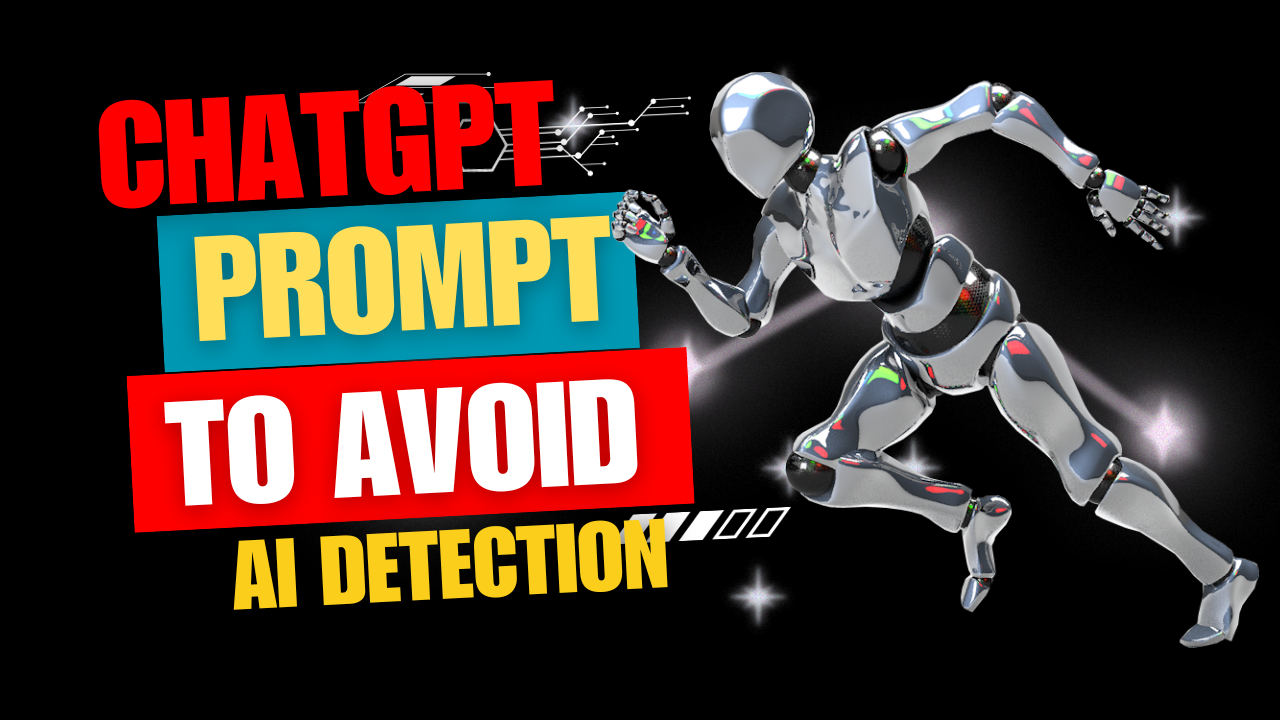Introduction: ChatGPT Prompt to Avoid AI Detection
In the ever-evolving digital landscape, the lines between human and machine interactions have become increasingly blurred. From chatbots that provide customer support to algorithms that generate content, artificial intelligence (AI) plays a pivotal role. However, this progress has given rise to a new challenge - AI detection.
Understanding AI Detection
AI detection is the process by which online platforms and services identify automated or non-human interactions. It helps distinguish between human users and AI-driven entities, such as bots, scripts, or algorithms. AI detection has gained significance due to its ability to combat spam, fraud, and misuse of online services.
Online platforms and social media networks use AI detection to safeguard their ecosystems, maintain user trust, and ensure fair and ethical usage. For example, it helps identify and remove automated accounts that spread misinformation, engage in spammy behavior, or violate platform policies.
The Implications of AI Detection
AI detection has far-reaching implications for how we interact online. When platforms accurately identify non-human entities, they can create a safer and more user-friendly environment. However, this also poses a challenge for those who wish to use AI responsibly, such as developers, businesses, or individuals who rely on AI tools and applications.
Imagine a scenario where you use an AI chatbot for customer service on your website. If the AI detection system categorizes your chatbot as non-human, it might limit its functionalities or even ban it. This is where "AI-resistant" prompts, including ChatGPT prompts, come into play.
ChatGPT, developed by OpenAI, is a powerful language model capable of generating human-like text. It has various applications, including content generation, answering questions, and even engaging in conversations. However, because it can generate text that is difficult to distinguish from human-generated content, it can sometimes trigger AI detection mechanisms.
In this blog post, we'll explore the world of ChatGPT prompts designed to avoid AI detection. We'll delve into the significance of creating AI-resistant prompts, techniques for crafting them, and strategies for staying ahead of evolving AI detection mechanisms. Whether you're a developer, content creator, or business owner, understanding these concepts can help you harness the power of AI while maintaining your online presence and interactions.
In the following sections, we'll dissect the nuances of AI detection and how to create AI-resistant prompts effectively. We'll also examine real-world case studies, tools, ethical considerations, and more. Let's dive into the world of AI detection and ChatGPT prompts designed to navigate it effectively.
Section 1: Understanding AI Detection
AI Detection Mechanisms
AI detection mechanisms are algorithms and processes employed by online platforms and services to differentiate between human and automated interactions. These mechanisms have become more sophisticated over time to adapt to the evolving strategies of malicious actors and ensure a safe online environment.
1.1 Types of AI Detection
AI detection mechanisms encompass various methods for identifying automated activity:
Pattern Recognition: These mechanisms analyze patterns of behavior and content to spot irregular or repetitive actions that might indicate automated activity. For example, an algorithm can detect patterns of spammy comments or bot-generated content.
User Behavior Analysis: Some platforms analyze user behavior, including the speed and consistency of interactions. Sudden surges in activity, such as posting a high volume of content in a short time, can trigger alarms.
Machine Learning Models: Machine learning models are trained to recognize anomalies in data. They learn from historical examples and can identify unusual patterns in user behavior or content generation.
CAPTCHAs and Challenges: Platforms often use CAPTCHAs and challenges to verify that the user is human. These tests require solving puzzles or recognizing objects within images, tasks that can be challenging for automated systems.
1.2 The Cat-and-Mouse Game
As AI detection mechanisms become more sophisticated, those who wish to bypass them develop increasingly advanced strategies. It's a continuous cat-and-mouse game. When AI detection improves, so do methods for evading detection. As a result, even AI systems like ChatGPT can sometimes be inadvertently flagged as non-human.
1.3 The Role of ChatGPT
ChatGPT, with its ability to generate coherent and contextually relevant text, is an invaluable tool for various applications. However, its outputs can sometimes resemble human-generated text, making it susceptible to AI detection.
In this context, developers and users of ChatGPT need to understand AI detection and how to craft prompts that maintain their effectiveness while avoiding detection. We'll explore these techniques in the following sections.
Understanding the intricacies of AI detection is the first step towards creating prompts that are resistant to such mechanisms. In the next section, we'll delve into the art of crafting AI-resistant prompts, specifically for ChatGPT.
Section 2: Crafting AI-Resistant ChatGPT Prompts
The Challenge of AI Detection
AI detection mechanisms aim to filter out automated or undesirable content while permitting genuine interactions. ChatGPT, being a powerful language model, can sometimes trigger these mechanisms unintentionally. Therefore, creating AI-resistant prompts is crucial for achieving successful interactions with ChatGPT.
2.1 Strategies for Crafting Effective Prompts
To create ChatGPT prompts that avoid AI detection, consider the following strategies:
Contextual Information: Provide context in your prompt that aligns with the expected topic of the conversation. This makes the interaction more natural and less likely to trigger detection.
Human-Like Engagement: Craft prompts that sound like typical human interactions. This includes using polite language and maintaining a conversational tone.
Avoiding Spammy Elements: Stay clear of elements that are commonly associated with spam, such as excessive use of keywords, repetitive phrases, or irrelevant content.
Gradual Information Disclosure: Instead of asking for all the information at once, reveal details progressively. This mimics how a human would inquire and reduces the risk of triggering alarms.
2.2 Length and Complexity
The length and complexity of your prompts can also impact the likelihood of detection. Here's what to consider:
Prompts Length: Extremely long prompts can sometimes raise suspicion. They may be seen as an attempt to overload the system. Try to keep your prompts reasonably concise.
Varied Sentence Length: Mix shorter and longer sentences in your prompts. A prompt with only short, similar-length sentences might look automated.
Error Introducing: Occasionally introducing minor grammatical errors or typos can make the interaction seem more human-like. However, this should be done sparingly and naturally.
2.3 Adapting to Feedback
It's essential to monitor the success of your prompts and adapt as needed. If you notice that a specific prompt frequently triggers AI detection, analyze what aspects might be causing it and adjust your approach accordingly.
By following these strategies and being attentive to the nuances of ChatGPT's responses, you can craft prompts that are both effective in generating responses and resilient against AI detection mechanisms.
In the next section, we will explore the art of prompt creation and how it plays a pivotal role in guiding ChatGPT to generate realistic and useful content.
Section 3: The Art of Prompt Creation
Initiating Captivating AI Interactions
Effective prompt creation is an art that can significantly enhance your interactions with ChatGPT. This section will delve into the various aspects of crafting prompts that lead to captivating AI interactions, producing responses that align with your objectives.
3.1 Understand Your Objectives
Before diving into prompt creation, it's crucial to have a clear understanding of what you want to achieve. Define your objectives:
Information Retrieval: If your goal is to gather specific information, structure your prompts to encourage comprehensive answers.
Creative Content: If you're looking for creative or imaginative responses, provide open-ended and engaging prompts.
Conversational Flow: To maintain a conversational flow, make sure your prompts logically follow the previous interaction.
3.2 Engage Your AI Assistant
ChatGPT performs best when it has a sense of context and purpose. Here's how to engage your AI assistant effectively:
Provide Context: Begin the conversation with a brief context or introduction. This helps ChatGPT understand the topic and provide relevant responses.
Maintain Conversational Flow: Refer to previous messages to create a sense of continuity. You can use references like "as we discussed earlier" or "you mentioned."
Ask Open-Ended Questions: Encourage ChatGPT to think creatively by posing open-ended questions that require thoughtful answers.
3.3 Use Politeness and Clear Language
The tone and language you use in your prompts can influence the quality of responses. Keep these tips in mind:
Politeness: Maintain a polite and respectful tone. ChatGPT responds better to respectful prompts.
Clarity: Use clear and concise language. Avoid jargon or overly complex sentences that might confuse the model.
3.4 Experiment and Refine
Crafting effective prompts often involves some trial and error. Don't hesitate to experiment with different approaches. If you find a specific prompt style consistently leads to better results, incorporate it into your strategy.
3.5 Example Prompt Creation
To illustrate the process, here's an example of crafting a prompt for different objectives:
Information Retrieval: "Can you provide details on the latest developments in renewable energy technology?"
Creative Content: "Imagine a world where humans have colonized Mars. Describe the daily life of a Martian colonist."
Conversational Flow: "Building on our previous discussion about travel destinations, let's explore more exotic places. What's your take on the Galápagos Islands?"
In the next section, we'll dive deeper into strategies for optimizing your prompts to ensure they align with user intent.
Section 4: Strategies for Optimizing Dan Chat GPT Prompts
Aligning Prompts with User Intent
In the world of chat-based AI interactions, ensuring that your prompts align with user intent is paramount. In this section, we'll explore strategies to optimize your prompts for different objectives, leading to more successful and efficient interactions with Dan Chat GPT.
4.1 Start with a Clear User Intent
Defining the user's intent is the foundation of effective prompt engineering. The user's intent is what they want to achieve through their interaction with the AI. It can be anything from acquiring information to generating creative content or simply maintaining a conversational flow. Here's how to start with a clear user intent:
Define the User's Goal: Understand what the user wants to achieve in their conversation with Dan Chat GPT. Are they seeking information, brainstorming ideas, or just engaging in casual conversation?
Understand User Context: Consider the user's background or context, as this can influence their intent. Someone asking about "Mars missions" might have a different intent if they are a space enthusiast compared to a student working on a research paper.
4.2 Craft User-Centric Prompts
Once you've identified the user's intent, it's essential to craft prompts that cater to that intent. Here are some tips:
Ask Specific Questions: If the user's intent is information retrieval, frame questions that elicit precise answers. For example, "Can you provide statistics on global carbon emissions in the last decade?"
Encourage Creative Thinking: If the user's intent is to generate creative content, use prompts that stimulate imagination. For instance, "Imagine a world without electricity. How would people's daily lives change?"
Maintain Context: In conversations that should flow smoothly, prompts should reference earlier interactions. Keep the context alive with prompts like, "As we discussed earlier, let's explore the topic of AI in healthcare."
4.3 Consider User Feedback and Iteration
Effective prompt engineering often involves an iterative process. User feedback can be invaluable in refining your prompts. After interactions with Dan Chat GPT, take note of what worked and what didn't. User feedback can reveal areas where your prompts might need improvement.
4.4 Optimize for Conciseness
While detailed prompts can be beneficial, it's essential to balance them with clarity and conciseness. Ensure that your prompts are not overly complex or lengthy, as this might confuse the AI. Aim for prompts that are straightforward and to the point.
4.5 Embrace a User-Centric Approach
Ultimately, the success of your prompts hinges on their alignment with user intent. Always prioritize what the user aims to achieve in their interaction with the AI. Crafting prompts with a user-centric approach will lead to more efficient and satisfying experiences.
In the next section, we'll explore real-world applications of Dan Chat GPT prompts, demonstrating how effective prompts impact various scenarios.
Section 5: Real-World Applications of Dan Chat GPT Prompts
In this section, we delve into the practical applications of Dan Chat GPT prompts across various domains. You'll discover how well-crafted prompts can drive results and enhance user experiences in real-world scenarios.
5.1 Content Generation
One of the prominent applications of Dan Chat GPT is content generation. Whether you're a content marketer, blogger, or social media manager, you can leverage the power of well-structured prompts to generate blog posts, articles, social media content, and more.
5.2 Customer Support Chatbots
Many businesses employ AI-powered chatbots for customer support. These chatbots rely on prompts to provide assistance and resolve customer inquiries. Effective prompts enable chatbots to understand and address user concerns accurately and efficiently.
5.3 Idea Generation and Brainstorming
In creative industries, such as advertising and product development, Dan Chat GPT can be a valuable asset. By using prompts that encourage brainstorming, you can tap into the AI's ability to generate creative ideas and concepts.
5.4 Language Translation
Dan Chat GPT can assist in language translation tasks. Effective prompts in this context may involve requesting translations, clarifications on phrases, or ensuring that translations maintain the appropriate tone and context.
5.5 Coding and Programming Assistance
For developers, prompts can facilitate coding tasks. You can use prompts to request code snippets, explanations of programming concepts, or assistance in troubleshooting code-related issues.
5.6 Educational Support
In the field of education, prompts can guide AI in providing informative responses. These prompts may cover a wide range of subjects, from mathematics and science to history and language learning. They help create engaging and educational interactions for students.
5.7 Data Analysis and Reporting
Data analysts and researchers can benefit from AI assistance in data analysis and report generation. Well-crafted prompts can guide the AI to perform specific analyses, generate visualizations, and create comprehensive reports based on the data provided.
5.8 Creative Writing and Storytelling
For aspiring writers and storytellers, prompts can be a source of inspiration. They can guide Dan Chat GPT to help craft stories, scripts, or poetry. The AI can generate character dialogues, plot twists, and imaginative scenarios with the right prompts.
5.9 Scenario Simulations
Prompts can be used for scenario simulations, particularly in fields like emergency management, healthcare, and military training. They enable AI to respond realistically to various scenarios and provide valuable training and decision-making support.
5.10 Legal and Compliance Queries
In the legal field, prompts can help lawyers and legal professionals get quick answers to legal queries, find relevant case precedents, or draft legal documents efficiently.
By understanding these real-world applications, you can tailor your prompt engineering skills to suit your specific needs, whether in content creation, customer support, or any other domain. In the next section, we'll explore the tools and resources available for Dan Chat GPT prompt creation. These resources can enhance your ability to craft effective prompts for various applications.
Section 6: Tools and Resources for Dan Chat GPT Prompt Creation
Creating effective prompts is essential to harness the capabilities of Dan Chat GPT fully. In this section, we'll explore various tools and resources that can aid you in crafting prompts for different applications. These tools and resources are valuable assets in enhancing your prompt engineering skills.
6.1 OpenAI GPT-3 Playground
The OpenAI GPT-3 Playground is a user-friendly platform for experimenting with prompts and generating responses. It allows you to test different prompts and observe the AI's output. You can fine-tune your prompts here to achieve the desired results.
6.2 Prompt Libraries
Several prompt libraries and collections are available online. These libraries contain pre-designed prompts that have proven to be effective for specific tasks. You can use these prompts as a reference or modify them to suit your needs.
6.3 Prompt Generators
Some online tools and prompt generators are designed to help you create prompts tailored to your objectives. They can provide suggestions and examples based on your input, making prompt creation more efficient.
6.4 Community Forums and Discussion Groups
Online communities, such as forums and discussion groups, are valuable resources for prompt engineers. You can engage with fellow users to exchange ideas, share effective prompts, and seek advice on prompt optimization.
6.5 AI-Assisted Prompt Creation
Emerging AI-driven tools are capable of assisting in prompt creation. These tools analyze your content requirements and suggest prompts that align with your goals. They can save time and improve prompt effectiveness.
6.6 Online Tutorials and Courses
Various online tutorials and courses focus on prompt engineering for AI models. These resources provide in-depth guidance on crafting prompts, optimizing them, and achieving specific outcomes.
6.7 Natural Language Processing (NLP) Libraries
NLP libraries like spaCy and NLTK can be useful for pre-processing text and creating prompts. They offer features for tokenization, syntax analysis, and semantic understanding, which are essential for generating effective prompts.
By leveraging these tools and resources, you can streamline the prompt creation process and enhance the quality of your interactions with Dan Chat GPT. In the following section, we'll explore common pitfalls to avoid when crafting prompts to ensure successful and error-free interactions.
Section 7: Common Pitfalls to Avoid in Dan Chat GPT Prompts
Crafting effective prompts is crucial, but it's equally important to be aware of common pitfalls and challenges that can affect the quality of interactions with Dan Chat GPT. In this section, we'll delve into these potential issues and provide guidance on how to avoid them.
7.1 Ambiguity in Prompts
Ambiguous prompts can lead to unexpected or unclear responses from the AI. To avoid this, be explicit in your prompts, providing sufficient context and specifying what you want from the AI.
7.2 Overly Complex Prompts
While precision is essential, overly complex prompts with lengthy sentences or convoluted language can confuse the AI. Keep your prompts concise and straightforward for better results.
7.3 Inadequate Testing
Failure to thoroughly test your prompts can result in suboptimal outcomes. Always test your prompts and iterate as needed to ensure they achieve the desired objectives.
7.4 Ignoring Model Limitations
Dan Chat GPT, like any AI, has limitations. It may provide inaccurate or biased information. It's crucial to verify the AI's responses and not assume they are always correct.
7.5 Lack of Clear Instructions
If your prompt lacks clear instructions, the AI might generate irrelevant or unhelpful responses. Provide specific guidelines to direct the AI effectively.
7.6 Neglecting User Intent
Understand the intent of your users or the task at hand. Failure to align prompts with user intent can lead to irrelevant or off-topic responses.
7.7 Repetitive Prompts
Repeating the same or similar prompts can limit the diversity of responses. Use a variety of prompts to explore different angles and generate fresh content.
7.8 Not Using Control Tokens
Control tokens, like temperature and max tokens, allow you to influence the AI's output. Failure to use these tokens when necessary can result in unpredictable responses.
7.9 Ignoring Ethical Considerations
Always consider ethical aspects when creating prompts. Avoid generating harmful, discriminatory, or inappropriate content.
7.10 Neglecting Feedback and Iteration
Continuous improvement is key to successful prompt engineering. Collect user feedback, analyze AI responses, and iterate your prompts to enhance their quality over time.
By being aware of these common pitfalls and implementing best practices, you can create prompts that maximize the potential of Dan Chat GPT while avoiding potential issues. In the next and final section, we'll wrap up our discussion on prompt engineering.
Conclusion: ChatGPT Prompt to Avoid AI Detection
In this comprehensive guide, we've explored the art of prompt engineering for Dan Chat GPT. Whether you're a seasoned content creator, a marketer, or just someone curious about harnessing the power of AI-generated text, you now have the knowledge to craft effective prompts that yield outstanding results.
We began by understanding the fundamentals of prompt engineering and how it plays a pivotal role in shaping AI interactions. We then delved into crafting effective Dan Chat GPT prompts, emphasizing the importance of clarity, conciseness, and relevance.
Moving forward, we explored advanced strategies for optimizing prompts, ensuring that your inputs align seamlessly with your desired outputs. Real-world applications shed light on the versatility of this technology, from content generation to problem-solving across various domains.
We didn't stop at theory; we equipped you with valuable tools and resources to make prompt creation a breeze. You also gained insights into common pitfalls to avoid, ensuring that your interactions with AI remain productive and ethical.
As you embark on your journey with Dan Chat GPT, remember that prompt engineering is both a science and an art. It's a dynamic process that involves continuous learning, experimentation, and adaptation. The key to mastering it lies in practice, feedback, and iteration.
We hope this guide empowers you to unlock the full potential of Dan Chat GPT in your projects, whether it's content creation, customer support, or research assistance. By implementing the techniques and principles covered here, you'll create prompts that not only enhance the quality of AI-generated content but also elevate your efficiency and productivity.
Thank you for joining us on this exploration of prompt engineering. If you have any questions or need further assistance, don't hesitate to reach out. The world of AI is evolving rapidly, and prompt engineering is your gateway to harnessing its limitless possibilities.
Ready to craft your first AI-powered interaction? Explore the potential of Dan Chat GPT and watch your ideas come to life!
We hope you found this blog post informative and inspiring. Stay tuned for more exciting content on prompt engineering and AI advancements.
With that, we conclude this blog post. If you have any more questions or need assistance with any topic related to prompt engineering or AI, feel free to reach out.
FAQ: ChatGPT Prompt to Avoid AI Detection
Q1: What is the significance of prompt engineering in AI language models like Dan Chat GPT?
Prompt engineering is crucial for effectively instructing AI language models. It involves crafting clear and specific inputs that guide the model to generate desired responses. This process ensures that the AI understands the user's intent and context, leading to more accurate and relevant outputs.
Q2: Can you share some best practices for creating effective prompts?
*Certainly! Here are some best practices:
Be clear and concise in your prompts.
Provide context when necessary.
Use detailed and specific instructions.
Experiment and iterate with different prompts.
Maintain a conversational tone in your requests.*
Q3: Are there any tools or resources available for prompt engineering?
Yes, there are several tools and resources designed to facilitate prompt engineering. Some popular ones include OpenAI's GPT-3 Playground, ChatGPT, and user-friendly APIs that allow you to interact with AI models.
Q4: How can prompt engineering be used in real-world applications?
Prompt engineering has a wide range of applications, from content generation and customer support to data analysis and problem-solving. It can be employed in chatbots, virtual assistants, content creation, and even scientific research.
Q5: Is prompt engineering limited to specific industries or domains?
No, prompt engineering can be adapted to various industries and domains. It's a versatile technique that can be tailored to suit the needs of different sectors, making it applicable to a wide range of use cases.
Q6: How can I measure the success of my prompt engineering efforts?
The success of prompt engineering can be measured by evaluating the quality, relevance, and accuracy of the AI-generated responses. Metrics like user satisfaction, response coherence, and task completion can also be used to assess the effectiveness of your prompts.
Q7: What are the ethical considerations when using AI language models like Dan Chat GPT?
Ethical considerations include avoiding biased or harmful prompts, ensuring that AI-generated content complies with guidelines and regulations, and respecting user privacy. It's essential to use AI responsibly and with a focus on positive societal impact.
Q8: How can I get started with prompt engineering for Dan Chat GPT?
Getting started is easy. You can explore the available tools, experiment with prompts, and gradually refine your approach. Familiarize yourself with the specificities of Dan Chat GPT, practice, and learn from your interactions with the model.
Written by: Md Muktar Hossain
























